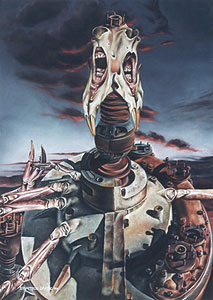information on © copyright & moral rights
All images and graphics contained on this website are copyright of Demetrios Vakras and are not for reproduction without the written permission of the artist.
Images on my links page are copyright of the individual artist or arts organisation there depicted.
This following section is a brief explanation on copyright & moral rights with attendant links to public bodies, like NAVA (National Association of the Visual Arts, of which I am a member) who represent artist's rights.
The intended purpose of this page is to explain why copyright should be observed on the basis of ethics as well as law.
Ethics first.
You might
like the artist's work, but don't feel you have to pay to support them.
What that means is that the artist, like myself, has had to do odd jobs
to support themselves in order to produce the work. Things like dental
care or a reasonable retirement fund, or a social-life are sacrificed in
order to earn some income to support oneself so as to produce the works.
The artist actually forfeits a decent wage, just to find the time to paint.
It means that if you feel it is okay to use my work without paying/or without
permission, that it is okay that I fill supermarket shelves every night
so that I can paint during the day, that I have consequent sleeping problems,
and that I am limited each year to the production of a paltry 3 to 4 oil
paintings when I should, given extra time afforded by selling my works,
be capable of producing 8+ pieces a year.
It is not for free that I produce the works. I have to pay for them. This cost is in the materials (canvas,paints,stretchers) as well as the income forfeited in not working full-time. It is an unreasonable expectation that somehow it is all for free. That this expectation exists is clearly evidenced in the success of Napster.
Put simply:
unless an artist's right to his/her own work is observed then you cannot
claim to support the artist or their work at all & are indeed antithetic
to the artist and their work altogether.
legal
"Copyright
is a collection of property rights based on a personís creative skill and
labour. The rights are protected in law .... Copyright is owned by the
artist (with specific exceptions) and comes into existence from the moment
a work is created. It allows the artist to benefit from the use of their
work in reproduction on paper, in photographs, on film and video, and in
digital form. Copyright only exists in artworks that have material form
- there is no copyright in ideas .... Copyright usually exists for a period
of 50 years after the death of the artist ...."*
quoted from: http://www.culture.com.au/nava/faqs/about_copyright.html
"The
owner of the artwork, if not the copyright holder, may not give this permission."
quoted from:
http://www.culture.com.au/nava/faqs/about_copyright.html
*(basically,
buying a painting does not constitute that the copyright becomes the province
of the buyer)
moral rights
Moral rights
are the rights the artist retains over their work after it is sold.
These rights are guaranteed internationally by the Berne Convention
for the Protection of Literary and Artistic Works. In Australia
on 7 December 2000 a bill protecting the moral rights of an artist's work
was passed in parliament.
What does this mean?
Well, you can't buy a painting and cut it down to size & fit it into a frame that you like ... you can't cut a painting into little pieces so that you can sell it in bits when the artist becomes famous ... And, for me it means, that in the future, I can pursue legal action against idiots who have destroyed my works upon buying them!
Case in point:

reaper
iii. oil on canvas. 1998
The above painting was purchased by a collector approximately 18+ months after it was painted. By this time oil paints have pretty much hardened. Mr. ** proceeded to take the canvas off its stretcher, mounting it (gluing it) onto a backing board. Not that bad you might say? Well, paintings are STRETCHED over a stretcher. The canvas is taut so that it does not sag & thus not touch the inner edge of the stretcher. (If Mr. ** wanted a mounted poster I do not know why he did not go out & buy one!)
Effectively by being removed from its stretcher the painting has shrunk in its dimensions by around 7mm (one quarter inch+) in height & width. This means that the painting will eventually begin to crack ... badly. Essentially the painting is now fu..#*ø..d.
The painting was created as canvas stretched over a stretcher & should not have been altered. The introduction of moral rights now entails that the work of artists is protected.
For more information regarding moral rights, refer:
http://www.culture.com.au/nava/issues/moral_rights_dec002.html
The links regarding
copyright etc. are hardly exhaustive. Here are a few:
http://www.copyright.org.au
http://fairuse.stanford.edu/rice.html
http://www.culture.com.au/nava/faqs/about_copyright.html
There are many more bodies which canvas the same issues.
To return to
my exhibition please use your browser's back button, regards, Demetrios.
